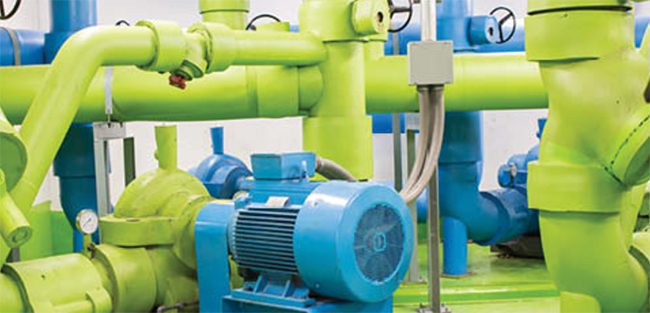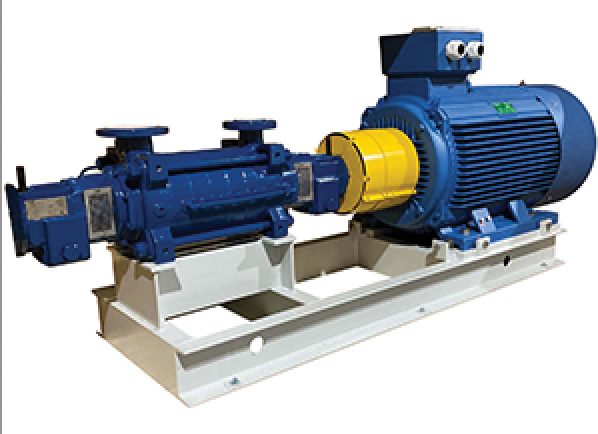Plant Operators Know Importance of Pumps and Piping Systems
Efficiency, safety, and providing support for optimal performance are key considerations when choosing equipment to move water and fuels through a power plant.
Power plant operators know the importance of pumps and piping systems to the performance of their facility. Several different types of pumps can be used in power plants, with a wide range of applications.
This includes boiler feed pumps, which are usually multistage and used to deliver feedwater to boilers. Other pump technologies include equipment to boost feeds and handle condensate, along with condenser and boiler circulating pumps, heater drain pumps, and more.
These pumps work in concert with piping systems to support plumbing as well as move water, gas, steam, oil, chemicals, compressed air, and in some cases ash or slurry. These systems also support fire protection, along with heating, cooling, and air conditioning in power plants and other industrial facilities.
Piping systems often are classified depending on the type of material used in the pipe, which could be metallic or non-metallic, a composite, or an internally lined system. These systems can impact the efficiency of a power plant, which can determine whether a generation facility can optimize its power output and its economics.
“Energy-efficient pumps reduce operating costs and environmental impact, aligning with sustainability goals,” said Campbell Tourgis, executive vice president and COO at Wainbee, one of Canada’s largest industrial distributors. “Customization ensures pumps meet unique operational requirements, enhancing reliability and compatibility with existing infrastructure.”
Tourgis told POWER, “One of the most important pumps in power plants today is centrifugal. These hydraulic machines move large volumes of liquid through a pipe to convert mechanical energy into hydraulic power… centrifugal pumps powered by artificial intelligence [AI] have robust data analytics and built-in sensors, optimizing performance and improving operational efficiency.
“With advancements in AI technology, piping systems will greatly enhance analyzing data on pressure, temperature, flowrates, and vibration,” said Tourgis. “[The technology] can detect and anticipate potential failures, which prevents costly downtime and repairs. Engineers can design and simulate piping systems through computational fluid dynamics simulations, improving efficiency, reliability, and safety in new installations.”
Efficient, Safe Operation
Peter Gaydon is deputy executive director of the Hydraulic Institute (HI), a U.S.-based group that’s considered a global authority on pumps and pump systems (Figure 1). The HI develops industry standards through an array of technical resources including application guidebooks, online tools, and calculators. Gaydon told POWER, “Pumps are becoming more connected in that they can have integrated sensors to aid in determining if they are operating properly and efficiently.”
 |
|
1. The Hydraulic Institute develops industry standards for industrial pumps, keeping operators abreast of the latest technologies, including for systems used in power plants. Courtesy: Hydraulic Institute |
Gaydon said power plant operators also need to look at safety considerations when choosing pumps and piping systems. “Safety is an important item to focus on, and should be the first item discussed,” said Gaydon.
“When selecting pump technology for power plants, safety is paramount,” said Tourgis. “This involves incorporating leak detection systems to promptly identify and address potential leaks, preventing hazardous fluid releases. Overpressure protection mechanisms prevent the pump from exceeding safe pressure limits, reducing the risk of equipment damage or catastrophic failures. Fail-safe mechanisms automatically shut down the pump during critical failures, minimizing equipment damage and the potential for accidents or injuries.”
Tourgis also told POWER, “With the rise of digital technologies, data security is crucial in pump technology. Manufacturers are implementing robust security measures and encryption techniques in intelligent centrifugal pumps to protect transmitted and stored data. These measures safeguard operational information, prevent unauthorized access, and ensure pump reliability in modern power plants.”
Application Considerations
The experts on pumps and piping systems who spoke with POWER said power plant operators should focus on the specific application required by the technology to make the best choice when it comes to choosing equipment.
“As plants [are] becoming increasingly automated some organizations are choosing to select pump designs that are easier to service,” said Pablo Martinez-Moore, commercial and marketing director at North Ridge Pumps, a UK-based industrial and marine pump supplier. “[This is] a strategy which pays dividends where access to highly technical or highly qualified staff is difficult, or in short supply. There are some designs of pumps which are a higher initial investment but much quicker to service, or have the option for ‘pump inserts’ where the main working parts of pumps can be easily changed, thus not requiring complicated or time-consuming service.”
“There are many pump types used in power plants and it is difficult to rank the importance because they all serve a dedicated purpose,” said Gaydon. “However, if we focus on the feedwater system, the condensate pumps start the process by pumping saturated water to heaters and eventually to the boiler feed pumps. The boiler feed pumps then pump the liquid into the boiler.”
Gaydon told POWER: “These pumps are engineered specifically for the demanding application considerations. For example, the condensate pumps are designed to have low net positive suction head [NPSH] requirements because the liquid is very close to its vapor pressure, and the boiler feed pumps are designed for high flowrates and high differential pressures so that the feedwater can be forced into the boiler.”
 |
|
2. This multistage boiler feed pump would be one of the most power-consuming pumps within a power plant. Proper maintenance of such pumps is important for continued optimal performance. Courtesy: North Ridge Pumps |
“Boiler feed pumps [Figure 2] are variable speed to accommodate fluctuations in demand,” said Martinez-Moore. “Due to water being pumped at high temperature there are often low levels of suction pressure available, meaning they are often fed by booster pumps to eliminate such issues. Sealing on such pumps is normally performed by mechanical seal or by packed gland, which can be preferred in applications where low NPSH conditions may be present, as mechanical seals can experience accelerated wear in such conditions.”
Said Gaydon, “The boiler feed pumps will be the highest power-consuming pumps because of the high flowrates and differential pressures. In traditional coal-fired power plants, these pumps can be up to 60,000 horsepower, so assessing the operation of these pumps regularly to maintain optimal efficiency can result in significant energy savings.”
Know the Variables
Power plant operators should consider several variables in determining the correct pump for use in a power plant. “The specific application considerations are the first place to start [flow, head, NPSH, temperature, fluid, etc.] and understand how variable they are,” said Gaydon. “Manufacturers that supply pumps for the power generation market will have designs targeted to each application.”
Gaydon told POWER, “Operationally, the most important consideration is selecting a pump that will operate near its best efficiency point, or BEP, during normal operations, and will always operate within its allowable operating region [AOR] for all conditions. The AOR is a range of flowrates where the operational reliability of the pump is acceptable.”
Some plants, such as combined heat and power, or those using oil- or diesel-powered turbines, will need fuel transfer pumps. Martinez-Moore told POWER, “Fuel transfer pumps, also known as fuel forwarding or feed pumps, ensure the turbines receive the required volumes of fuel, at the required pressure for burning efficiently. Fuels may be pumped to a nozzle where the fuel may be atomized, or directly to a burner where it should meet a defined duty point for the burner to produce the required heat.”
Martinez-Moore said, “A typical fuel forwarding pump set consists of a duty and standby pump to ensure redundant capacity, transducers to record the operating pump pressure, and an integrated control panel with variable frequency drive to vary pump speed according to the flow required.”
Moving Equipment
Pumping systems in power plants go beyond those used to move liquids; they also can help move equipment.
“High-pressure hydraulic pumps that allow the positioning of heavy objects within power plants are important to give users added flexibility and portability of what was traditionally a very onerous task,” said David Lundquist, global product manager of the SPX FLOW Power Team. “SPX FLOW, under the Power Team brand, manufactures pumps that feature The Power Team motion control system. This system was recently used for a 36-point hydropower rotor separation project. The project required a tilt feature to level the rotor before a 24-inch synchronous separation of the rotor for maintenance.”
Lundquist told POWER, “Customers have been asking for more solutions around several common challenges, including options to improve portability and usability, equipment that better pairs power with high flow capacity, and pumps that are durable enough for the most demanding applications.” Those applications include compatibility with piping systems, which can encompass water piping, including service and cooling water; fuel piping (for gas or fuel oil); and chemical piping (for ammonia, acid, etc.).
“When water is continually reused from cooling towers within a closed-loop system, the water can become contaminated due to it encountering particles such as dust, as well as [becoming] acidic due to the characteristics of the process and the materials in which the water comes into contact,” said Martinez-Moore. “In boiler feed applications, due to the nature of the process with the water being repeatedly boiled, the level of dissolved solids within the water continually increases, which can lead to scale accumulation and calcification forming within the [piping] system, with dosing pumps used for the control of water quality and efficient operation of the boiler.”
Martinez-Moore said water discharged from a plant should meet certain standards. “Dosing pumps are used to dose flocculant for the clarification of water, and [add] chemicals to correct water pH to ensure it meets the required levels for discharge consent,” he said.
Martinez-Moore noted that piping systems at power plants “can create the ideal conditions for the growth of Legionella bacteria, giving rise [to] the requirement for a dosing system for microbial control with biocides dosed to prevent Legionella,” referring to bacteria that causes Legionnaires’ disease. The U.S. Centers for Disease Control and Prevention has said controlling Legionella bacteria is an important consideration, and a major reason pipe systems at power plants must be “properly disinfected and maintained.”
—Darrell Proctor is a senior associate editor for POWER (@POWERmagazine).